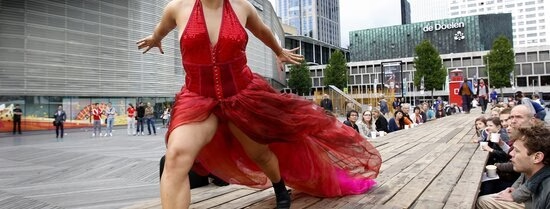Karen Klijnhout works on a Vital Cities and Citizens PhD project on the impact of cultural diversity on urban cultural organisations. She is specifically interested in processes and standards of evaluation and legitimation of art. In this blog, she reflects on what the current Corona crisis tells us about this topic and how it feeds into her research.
From nearness to distance
To me, city culture is an essential part of vital cities. For my current PhD project, I zoom in on performance arts-dance, music, theatre. These forms of art thrive in the city theatres, concert halls and also streets and parks -places where art is shared and developed, in encounters between artists and audiences. Physical nearness is arguably essential for these art forms: the close intensity of a play in a theatre, the shared experience of a concert, the magic of singing in a choir.
Suddenly, these live encounters stopped. Performances and rehearsals were cancelled or (indefinitely) postponed, nearness became distance. As a researcher, I run up against my own form of distance. Just as I was about to start my interviews with key figures involved in policy decisions on local art funding, live interviews became much more difficult. Additionally, the art field has been busy trying to grasp what all changes mean for their products and their existence, keeping up with changing regulations, fighting for financial compensation.
Changing perspectives
During the past year, I had been closely following the process of subsidy allocation for performance art - from political points of view to policies to the decision making within committees advising the government on financial support. The aim of my interviews was to scrutinise their visions on why art is important for the city, and how cultural projects and institutions are valued. Then, corona urged me to pause and rethink my planning, my questions, my role as a researcher.
As the first weeks of social distancing passed, I realised these times also give powerful answers to my questions. Reactions to the corona crisis show me a lot about conceptions of which art is important and why, and how different actors see their role in the art field. Either by consciously reflecting on their role, or by their actions, they are sending signals about the value of art.
Debates and actions revealing the value of art
Politicians and governments react to the crisis with extra financial support for crucial cultural institutions. But who is deemed crucial for the urban art field, and why? With their actions, politicians answer some of my questions of why arts and culture are important for a city.
Artists themselves are also showing me how they think about their role and the core of their work. Some of them debate their role publicly. Others do it more implicitly, through a variety of actions: finding alternative (digital) ways to share their work, making new work inspired by the current developments, advocating for the usefulness of artists in crisis management teams, pointing out how art brings people consolation or insights, or how it brings people together. All these efforts connect to different views on the role of artists, different values of art.
As audiences, or participants in arts and culture this crisis challenges us to reflect on the things we miss, and why we miss them. What makes an evening to the theatre special, what is the difference between an online and a live concert? Furthermore, we can think about what art does bring us during these times. Our preferences now also tell us something about what art means for us, what values it has.
Learning from a distance
This crisis also makes me reflect on my role as a scientist, and how to adjust to the changing environment. It stirs my curiosity, triggers feelings of responsibility. It makes it even clearer to me how I can add to both the development of academic knowledge, and to debates in society; by uncovering competing conceptions of city culture, reflecting on cultural policies, re-examining the role and value of art in a city. From a distance, I remember everything important and beautiful.
Vital Cities and Citizens
With the Erasmus Initiative Vital Cities and Citizens, Erasmus University Rotterdam wants to help improve the quality of life in cities. In vital cities, the population can achieve their life goals through education, useful work and participation in public life. The vital city is a platform for creativity and diversity, a safe meeting place for different social groups. The researchers involved focus on one of the four sub-themes:
- PhD student
- Contact

